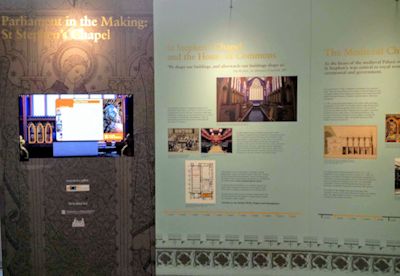A July in Westminster Hall
Posted on 2 September 2015
Liviu Tanasoaica
MA in Renaissance and Early Modern Studies, 2015
My IPUP-administered internship was with the University of York’s Department of History, working in close collaboration with the Parliamentary Estates Directorate. The project’s public manifestation, dubbed Virtual St. Stephen’s by the team, is part of a larger anniversary programme at the Palace of Westminster, Parliament in the Making. It entailed the creation of a computer-generated graphic reconstructing the appearance of the medieval chapel of St. Stephen (converted in c 1548 to become the first permanent meeting place of the House of Commons), and an exhibition presenting current project findings to the public. It is part of an ongoing AHRC-funded project, St. Stephen’s Chapel Westminster, Visual & Political Culture 1292–1941. As an intern, I was tasked with invigilating the exhibition, monitoring visitor reactions and collecting impact assessment sheets in the form of questionnaires, for quantitative public feedback of the exhibition and the overarching project.
My work started with a colloquium at the end of June and finished at the end of July. Overall it was a great experience, during which I learnt a great deal about the history of Westminster Hall, Parliament and St Stephen’s Chapel−some of the most important institutional spaces in the history of the country−and about the processes that lead towards exciting exhibitions.
The first day entailed a medieval music concert in the Victorian-style furnished Chapel of St. Mary Undercroft, a space which is not often open to the general public, as it is a Royal Peculiar (and thus closely associated with the Queen). The resplendent space had unique acoustic properties and thus was the perfect setting for the performance.
On most days, I likened my work with presenting the tip of an iceberg. Most of the work that went into the presentation was invisible, the product of the intellectual labour of dozens of passionate experts: historians, art historians, designers, affiliated researchers and PhD students. All this work had to transpire to the public through the display, through my enthusiasm and that of my colleagues. The questionnaires we gathered offer valuable insight into cultural consumer behaviour and habits, an ‘affective’ feedback, whereby visitors’ exclamations and reactions were recorded. The feedback also provided a powerful incentive for both staff and overarching institutions to continue the work.

Recording public engagement is essential in keeping projects like Virtual St. Stephen’s up and running. Visitors to Westminster Hall came from all over the world and were in awe of its architecture, its centennial history and significance for the country. Sometimes it was a difficult feat to divert their attention for a brief second from the overarching space to a forgotten one buried deep within the current architectural texture of Westminster Palace. Some mistakenly assumed that Westminster Hall itself is the chapel. But with patience, using our wonderful exhibition material, we managed to educate the public in the matter.
On a personal level, my internship has definitely increased my awareness of the world of work in the cultural and heritage industry. It made me understand a great deal about the organisational structure of large projects that lead towards exhibitions. While I had been involved with cultural projects at museums and galleries before, the scale on which the exhibition in Westminster Hall had to ‘perform’, with hundreds of visitors each day, was unlike anything else I had experienced. I learned a great deal about etiquette and gained awareness of the ethnic diversity in British cultural tourism. I understood what it means to work in a fast-paced environment, coordinate with a team of dozens of people, and report back to supervisors in a timely and professional manner.
Keeping the exhibition desk up to standard, arranging flyers and other material, making sure the exhibition panels are in order every day - all the minutiae of working for Virtual St. Stephen’s made for a rewarding experience once we read the questionnaires at the end of the internship. ‘What magnificent work! Hats off!’ spelt one of them… After my placement in an iconic space such as Westminster Hall, I feel as if I have been spoilt. I would love to work in such an environment in the future. I am sure that my experience with the exhibition will strengthen my CV towards this goal.
